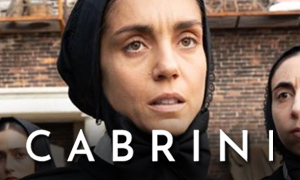Harriet: History vs. Hollywood
| REEL FACE: | REAL FACE: |
Cynthia Erivo
Born: January 8, 1987 Birthplace: Stockwell, London, England, UK | Harriet Tubman
Born: c. March 1822 Birthplace: Dorchester County, Maryland, USA Death: March 10, 1913, Auburn, New York, USA (pneumonia) Photo: 1870s |
Leslie Odom Jr.
Born: August 6, 1981 Birthplace: Queens, New York, USA | William Still
Born: October 7, 1821 Birthplace: Shamong Township, New Jersey, USA Death: July 14, 1902, Philadelphia, Pennsylvania, USA |
Zackary Momoh
Birthplace: UK | John Tubman
Harriet's First Husband |
Did Harriet Tubman really have Godly visions?
Yes. In the Harriet movie, these visions unfold before us in literal form as washed-out, crazed montages of people, birds, memories, and the future. The visions are at times strong enough to make Harriet (Cynthia Erivo) collapse. It's true she believed that the visions were spiritual messages from God. The Harriet true story reveals that they began after a head injury she received as a child between 1834 and 1836, when an enraged overseer threw a two-pound iron weight at a slave trying to run away, striking Harriet (then Minty) by accident. The impact cracked Harriet's skull and led to a lifelong battle with headaches, seizures and narcolepsy.
Did an examination of the will of Harriet Tubman's mother's former master reveal that she was legally free?
Yes. The movie opens with this lesser-known account from Harriet Tubman's life. In answering the question, "How accurate is Harriet?" we learned that when she was younger she did in fact hire a white lawyer to examine the will of her mother's former master. The lawyer indeed discovered that her mother, and in turn herself, were legally free. However, like in the movie, the family who now owned them chose to not let them go free.
Did Harriet Tubman really walk 100 miles to escape from slavery?
Yes. A Harriet fact check reveals that Tubman escaped from slavery, fleeing Poplar Neck in Caroline County, Maryland in September 1849. Using the North Star and rivers as her guides, she made her way to Pennsylvania and then headed to Philadelphia, a total distance of roughly 100 miles.
Did Harriet Tubman's two brothers retreat back to the plantation after escaping with her?
Yes. She invited her two brothers and her free husband, John Tubman, to flee to the North with her via the Underground Railroad. Her husband refused her invitation and decided instead to remain in Maryland. Her siblings fled with her but turned back out of cowardice.
Is Joe Alwyn's character, slave master Gideon Brodess, based on a real person?
No. Gideon (Joe Alwyn), the young slave owner who is portrayed as having been a childhood companion of Tubman, is entirely fictional. The character represents the many young people who grew up alongside the slaves owned by their parents. Gideon does share the same last name as Edward Brodess, Harriet's former owner who died in March 1849. In real life, Edward's death is what prompted Harriet to escape, since she was about to be sold to a new master farther south. In the movie, the fictional Gideon continues to pursue Tubman after her escape. Gideon's mother, Eliza Brodess (Jennifer Nettles), is based on a real person, Edward's wife. -The New York Times
Does the film draw on Harriet's real-life accounts?
Yes. Some of the movie's most memorable moments were taken straight from Harriet Tubman's real-life accounts. This includes her examining her hands in the sunlight when she crosses the border into Pennsylvania. The real Tubman recalled, "When I found I had crossed that line, I looked at my hands to see if I was the same person. There was such a glory over everything; the sun came like gold through the trees, and over the fields, and I felt like I was in Heaven."
Did she choose the name "Harriet Tubman" to mark her freedom?
Not exactly. Born Araminta 'Minty' Ross, the true story reveals that she changed her name to Harriet Tubman around the time of her first marriage. Tubman was the last name of the free black man she had married while enslaved, John Tubman. She chose Harriet for her first name to honor her mother.
Is Janelle Monáe's character, Marie Buchanon, based on a real person?
No. In conducting our Harriet fact check, we learned that the freeborn northern black, Marie Buchanon, portrayed by Janelle Monáe, is not based a real-life individual. However, there certainly were similar freeborn blacks who aided Harriet. In the film, Marie is a boarding house proprietor who helps Harriet Tubman (Cynthia Erivo) and teaches her how to behave like a proper free woman.
Did Harriet Tubman's husband marry someone else?
Yes. In researching the Harriet true story, we learned that following the death of her owner, Edward Brodess, in March 1849, Harriet Tubman was about to be sold. Instead of becoming the property of a new master farther south, she fled north to freedom. Her husband, John Tubman, a free man, decided to remain behind. He married a free woman, Caroline, and together they would have four free children. Like in the film, Harriet returned to rescue her husband, but he refused, preferring to remain in Dorchester County, Maryland with his new wife. He was killed there in 1867 during a roadside argument with a white man.
How many times did Harriet Tubman go back to free more slaves?
In researching how accurate the Harriet movie is, we learned that Tubman made approximately 13 trips from the South to the North, guiding slaves along the Underground Railroad to their freedom.
Did local plantations start calling her Moses?
Yes. Like in the movie, a Harriet fact check confirms that because her identity was unknown, coupled with the fact that she had freed so many slaves so quickly, local plantations began referring to her as Moses.
Did Harriet Tubman really use guns?
Yes. In the past, books and children's books about Harriet Tubman intentionally softened her image to make her seem more "ladylike". "Those books defanged her, declawed her, to make her more palatable," said Harriet director Kasi Lemmons. "Because there's something quite terrifying about the image of a black woman with a rifle." In reality, the real Harriet Tubman did carry guns. In fact, she was more closely in line with the action hero Cynthia Erivo portrays in Harriet than the toned-down, feminized versions we've seen before. The true story confirms that Tubman carried a pistol during the ten years she was a conductor with the Underground Railroad. She used it as protection against slave hunters, and, to a lesser degree, as shown in the movie, to persuade those with her not to turn back. She also carried a sharpshooter's rifle during the Civil War. -The New York Times
Was Harriet Tubman devoutly religious?
Yes. She had attended church services from the time she was a child. Prior to her freedom, she attended the churches of her masters, as slaves were often required to do. Thomas Garrett, a fellow Underground Railroad agent, said of Harriet, "[I've] never met with any person, of any color, who had more confidence in the voice of God, as spoken direct to her soul . . . and her faith in a Supreme Power truly was great."
Was there a bounty on Harriet Tubman's head?
Yes. There was indeed a bounty on Harriet Tubman's head. In the film, we see posters citing a bounty of $200 or $300. This is far more realistic than the often-repeated myth of $40,000. That is a ridiculously high number, especially given that the bounty on John Wilkes Booth's head was $50,000. If the number was indeed that high, she would have certainly been captured. Below is an ad taken out by Eliza Brodess after Harriet's escape. Harriet is referred to by her birth name, Minty, in the ad. -The New York Times
How many slaves did Harriet Tubman free through the Underground Railroad?
After she managed to escape, Harriet was involved in freeing around 70 other slaves during the ten years she was with the Underground Railroad. It helped make her one of the most famous "conductors" on the Railroad. Harriet's 1869 biography puts the number she freed at 300, but it is now believed that the biography embellished her story in an effort to sell it.
In addition, during her time with the Union Army in the Civil War, she was involved in a large military operation that freed more than 750 slaves. -The New York Times
Did Harriet Tubman act as a spy during the Civil War?
Yes. Tubman had several alternating roles during the Civil War, including working as a nurse, scout, spy and cook for the Union Army. As a nurse, she provided care to both wounded soldiers and liberated slaves. Her duties grew to include scouting and spying behind Confederate lines. She is credited as being the first woman to lead an armed raid into enemy territory. In June 1863, she led Colonel James Montgomery and his Second South Carolina Black regiment up the Combahee River, overtaking Confederate outposts and liberating over 700 slaves along the way.
Did Harriet Tubman ever remarry?
Yes. In 1869, she married a veteran named Nelson Davis (pictured below), who was more than 20 years her junior. In 1874, they adopted a baby girl named Gertie.
Videos: Harriet Tubman Documentary, Movie Trailer
As we explored the answer to, "How accurate is Harriet?" we discovered the short documentary below that provides an overview of Harriet Tubman's life. Also view the movie's trailer.







